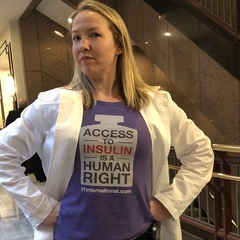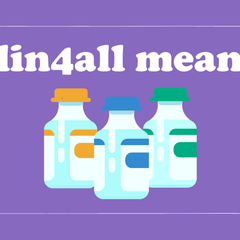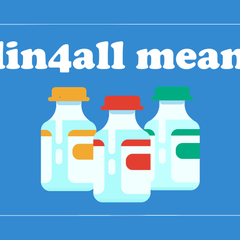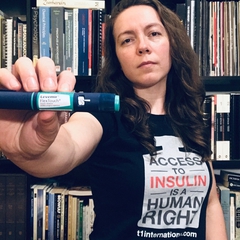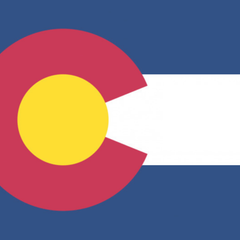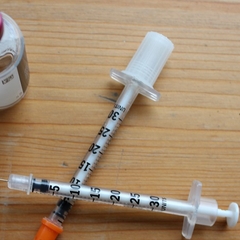
340B, An Under-Utilized Program that May Help
22 Nov 2019, 2:22 p.m. in #insulin4all USA by Christopher Rapp
Addendum, December 18, 2020:
As of December 3, 2020, all three insulin manufacturers have announced that they will refuse to offer 340B pricing to eligible pharmacies. This move ignores the manufacturers' commitments under federal law, and will severely limit low-income patients' ability to access insulin and other medications at a cost they can afford. Read on to learn more about one patient's experience buying insulin through a pharmacy that gets discounts because of this program.
Original Post, November 22, 2019:
I got 20 vials of Humalog insulin for $17.40. If you live in the USA, you may be able to, too. Through the little known and vastly underused 340B program, drug makers provide discounted medicine to anyone willing to cut through some red tape.
What is the 340B program?
The 340B program was established by Congress in 1992 after complaints about the Medicaid Drug Rebate Program arose from key players, such as healthcare organizations like hospitals with a higher share of Medicaid patients. This July 2019 study from the Journal of the American Medical Association provides full details about access and pricing mechanics. For people with diabetes, the most important participant in the 340B program is community health centers, which provide discounted insulin.
How to use 340B
To acquire insulin through the 340B program, you need a 340B prescription from a community health center. You can find one near you online. You can set up an appointment just as you would with any other doctor’s office. Be sure to ask if they do 340B prescriptions for insulin. Once that is confirmed, set an appointment. There are no income limits. There is no prohibition on using private insurance for the prescription or the health center visit.
At my appointment, the doctor asked standard issue diabetic questions (counting carbs, seeing an eye doctor, etc.) and did a finger prick A1C test. He wrote the 90-day prescription for 20 vials and sent it to the health center’s pharmacy.
Here is where you have to cut the red tape just right. They will either fill it at your clinic’s own pharmacy or at their 340B-contracted pharmacy. You must go to their pharmacy or their contracted one. Do not use mail order, discount cards, or anything else. For me, that meant going to a Walgreens inside a hospital. Twenty minutes later, they handed me a bag with $6,500 worth of list price insulin. I gave them a $20-bill and got $2.60 back.
PhRMA, Hospitals, and 340B Pharmacies
So problem solved right? Cheap insulin for all? Not quite. Predictably, pharmaceutical companies do not care for providing discounts. 340B pricing is determined by the average manufacturer price reduced by the unit rebate amount. They have to give even greater discounts if the price increases more than the rate of inflation. In simple English, this means pharmaceutical companies do not get to blame PBMs - the more they raise their price, the more the 340B discount has to be by law.
Hospitals and pharmacies don’t have clean hands here either. While drug companies have to sell the hospitals and pharmacies drugs such as insulin at the 340B rate, they don’t have to bill insurance companies at the 340B rate. According to my receipt, my insurance saved me $6,481.79. My insurer is paying Walgreens that amount. Hospitals, particularly rural ones, use this to stretch their other resources.
PhRMA is, unsurprisingly, upset by this. Their number 1 complaint is “patient definition.” They argue that the 340B program should only be helping vulnerable or uninsured patients.
Good News
The July 2019 JAMA study demonstrates the best reason for every person with diabetes to get their insulin through the 340B program - it incentivizes PhRMA to lower the list price for drugs. For patients with Hepatitis C, the 2014 release of the medication sofosbuvir was monumental. The medicine effectively cured the disease. However, the price was steep. In 2016, one pill cost $1,000 in the U.S., while in India, it cost $4.
When prescriptions for the Hepatitis C medicine approached 40% being filled through the 340B program, the pharmaceutical company who produced it began to lower the price. The higher percentage of prescriptions that were 340B prescriptions, the more incentive pharma had to lower the list price. While the JAMA study does not exactly include insulin, it does list data on “blood glucose regulators,” of which 15.5 percent are currently prescribed through the 340B program. If we as a community increase our use of the 340B program so that 50% or more of prescriptions for insulin are filled through the 340B program, the pharmaceutical industry will have to reduce costs.
Let’s end rationing. Let’s end the deaths. Go to your local community health clinic and get a 340B prescription. It will save your lives and others.
If you are struggling to afford insulin in the U.S., check out T1International’s list of emergency resources.




